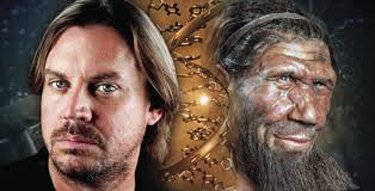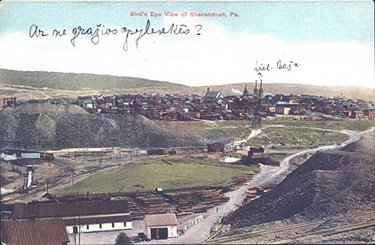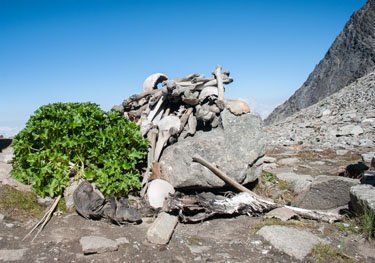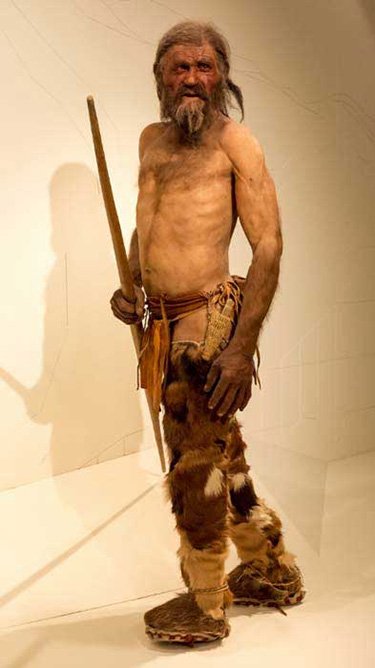Category Archive 'DNA'
07 Jan 2023


Ron Liddle took one of those DNA tests and was startled by its findings.
I did not enjoy the Christmas festivities this year: I sang no carols, ate no turkey and failed to watch It’s a Wonderful Life. There were two reasons. First, I received my DNA heritage results from a company I’d bunged £100 or so back in the autumn. My family had been greatly looking forward to this event, hoping for a revelation that I was part Igbo or Hausa or, better still, related somehow to the unfriendly pygmies of the western mountains in Papua New Guinea. Meanwhile I was hoping to be 90 per cent English with the remaining 10 per cent Danish, as I have often considered myself to be distantly related to the Viking hero Ragnar Lodbrok, which may account for my political disposition.
I have often considered myself to be distantly related to the Viking hero Ragnar Lodbrok
So I tapped on the screen with high expectations, family gathered around, and could not have been more appalled if it had been revealed that I was descended from Belgians. I got my wish for some Danish and/or Swedish lineage – about 3 per cent, it said. And there was some English in me too – 20 per cent. The rest, more than three-quarters, was… Scottish. I am almost entirely Scottish. The family howled with mirth while I sat there, checking and re-checking that I hadn’t typed in the wrong name or something, utterly devastated. Hell, I knew there was some Scottish blood on my mother’s side – 87 per cent, as it turned out – but surely not from my dad, whose entire family had lived in County Durham for generations. Yup, Dad was 65 per cent Scottish too.
Imagine how this feels! One moment you are comfortable with the notion of yourself as a decent, solid, industrious Englishman – and then it is revealed that you are, instead, a chippy, grasping, salad-dodging smackhead who is unable to define the term ‘woman’. It is like suddenly finding out, at the age of 62, that you were adopted and your real parents were serial killers. I suppose it explains why, during a hot summer, I totally fail to tan but instead resemble the victim of acute radiation poisoning, suffering cracked and flayed skin, bleeding gums and hair loss. Such a shattering blow to one’s self-esteem and self-worth. The only consolation is that henceforth I shall expect everybody else in England to subsidise me through their taxes, while simultaneously demanding total independence from them.
RTWT
24 Apr 2021


Hugh Thomson, in the British Spectator, finds membership in a new Identity Group.
My brother recently decided to get a DNA test. He discovered that our family were all descended from a mix of the usual British suspects — a bit of Viking, Anglo-Saxon and Celt — and were predisposed to standard diseases and health risks. But there was one surprise. My siblings and I had double the normal amount of Neanderthal in our genes.
Reactions were mixed. My girlfriend declared she had suspected something of the sort for some time. My mother announced that it must come from my father’s side of the family. And it took us a while to digest. …
..then came help. I stumbled on an attractive scholarly thesis which proposed that the Neanderthal element within Homo sapiens was the part that added interest —that was, so to speak, the little spike of mustard in the mix. It can give a creative spark and has allowed us as a species to think outside the box. According to this thesis, the Neanderthal is the Mac component, with the design flair, while standard Homo sapiens is the boring old PC. Neanderthals were wilder, improvisational, free — and, the palaeontologists have shown, had bigger brains. The more Neanderthal you have within you, the more likely you are to break loose.
To say this came as a pleasurable hypothesis would be an understatement. Not only could I now frame myself as a proud Neanderthal, but as a middle-aged, middle-class white man living in the south of England, it could give me something I badly needed — identity politics.
Use Outline.com to beat the paywall.
19 Apr 2020


The Atlantic has news about an interesting new approach to DNA study.
The York Gospels were assembled more than a thousand years ago. Bound in leather, illustrated, and illuminated, the book contains the four gospels of the Bible as well as land records and oaths taken by clergymen who read, rubbed, and kissed its pages over centuries. The Archbishops of York still swear their oaths on this book.
The York Gospels are also, quite literally, a bunch of old cow and sheep skins. Skin has DNA, and DNA has its own story to tell.
A group of archaeologists and geneticists in the United Kingdom have now analyzed the remarkably rich DNA reservoir of the York Gospels. They found DNA from humans who swore oaths on its pages and from bacteria likely originating on the hands and mouths of those humans. Best of all though, they found 1,000-year-old DNA from the cows and sheep whose skin became the parchment on which the book is written.
Remarkably, the authors say they extracted all this DNA without destroying even a tiny piece of parchment. All they needed were the crumbs from rubbing the book with erasers, which conservationists routinely use to clean manuscripts. The authors report their findings in a preprint that, as of this article’s publication, has not yet been peer-reviewed, though they plan to submit it to a scientific journal.
If their technique works, it could revolutionize the use of parchment to study history. Every one of these books is a herd of animals. Using DNA, researchers might track how a disease changed the makeup of a herd or how the skin of sheep from one region moved to another medieval trade routes. It’s part of a growing movement to bring together scholars in the sciences and humanities to study medieval manuscripts.
Scientists have extracted DNA from parchment before, but this non-destructive technique expands the potential pool of research material. Archivists are loathe to allow researchers to cut off a piece of, say, the York Gospels, but some eraser crumbs? Sure. “That’s why it’s such an exciting breakthrough. It allows a lot of different manuscripts from a lot of different areas to be analyzed together,†says Bruce Holsinger, an English professor at the University of Virginia who is writing a book about parchment.
The idea to study parchment came to Matthew Collins, an archaeologist at the University of York, after a failed study in bones. A few years ago, he had a graduate student trying to extract ancient DNA from animal bones at an old Viking settlement. There were thousands of bones on the site, but only six that they tested yielded DNA—too few for any statistically significant results. “You can imagine the frustration,†says Collins.
So Collins got to thinking about archives full of old manuscripts. “You look at these shelves, and every one of them has a skin of an animal with a date written on it,†he says. Suddenly you have thousands of animals. And you didn’t even need to go out into the field and dig.
RTWT
30 Dec 2019


Want your kid to grow up to be a doctor, or at least an orthodontist? Dominic Green gives an insider’s perspective on the Ashkenazi Jewish penchant for intellectual achievement.
There I was, watching my old VHS copy of The Boys from Brazil, idly reading the lab reports on the swabs I took from my gentile neighbor’s kids when he wasn’t looking, and revising the bassoon part of a concerto I’ve been working on, when I saw something alarming trending on Twitter. Not ‘eugenics’, but ‘Bret Stephens’.
‘What’s he done now?’ I asked in six languages, two of them not from the Indo-European language family.
In today’s New York Times, Bret Stephens discusses Norman Lebrecht’s excellent new history of the Jews in modern times. Lebrecht describes the unparalleled contributions of notorious underachievers like Marx, Freud, Heine, Disraeli, Herzl, Trotsky, Kafka, Wittgenstein and Einstein but, inexplicably, he fails to mention the contributions of members of the Green family — a lacuna that I, with my inherited Ashkenazi acumen, can already see him correcting in the paperback edition.
Lebrecht specifically does not attribute Jewish success to ‘Jewish DNA’. He attributes it to environmental factors: the Jewish tradition of Talmudic study, which produced near-universal adult literacy among Jewish males when most Europeans couldn’t even write ‘well-poisoner’ in blood; to the cultural imprint of intellectual labor even among secular Jews; to the Jewish emphasis on hard work, family and education; and to the perennial threat of violence, as nothing concentrates the mind like the prospect of your neighbors burning you and your children alive in your home.
There is solid evidence for all these environmental factors, and plenty of evidence that similar factors apply to many other minorities. There is less solid evidence for genetic factors in Jewish achievement, and especially epigenetic factors (changes in gene expression in living organisms, presumably due to environmental factors). Bret Stephens summarizes all this by saying, ‘Jews are, or tend to be smart’.
This is not terribly smart. Perhaps it reflects the errors of compression that go into editing. The evidence that we have — and it would be interesting to have more — is that Jews aren’t much smarter than any other group. The difference is that they produce high-achieving intellectual outliers at a slightly higher rate. As in athletics, so in the life of the mind: the higher you get, the more marginal the advantages become.
Stephens also refers to a genetic study from 2005. This is an interesting study — you see, we read all the time. In particular, it challenges the ‘bottleneck theory’ (Ashkenazi genes were ‘bottlenecked’ in the early Middle Ages) and instead focuses on how ‘intelligence in heterozygotes’ are increased by the ‘well-known clusters of Ashkenazi genetic diseases, the sphingolipid cluster and the DNA repair cluster’. I want you to know that I understood that first time round, while making a pastrami sandwich. …
If you wish to avail yourself of the secrets of Jewish genius, there are two simple courses of action. One is to enlist your children at an early age in the study of the Talmud, and teach them the values of ethics, work and family, which are also the near-universal immigrant virtues. This will be demanding for both them and you: helping them with math homework will be a cinch by comparison.
The other option is to hire Jewish people who show marginal aptitude in their fields of specialization. This is the much less demanding course to take, and it is much more likely to lead to success in the long run. But it does mean refraining from chasing them out of the universities, the professions and the Democratic party. So, be smart like us.
RTWT
18 Dec 2019


Wired reports the results of an interesting study of ancient human DNA.
Nearly 6,000 years ago, in a seaside marshland in what is now southern Denmark, a woman with blue eyes and dark hair and skin popped a piece of chewing gum in her mouth. Not spearmint gum, mind you, but a decidedly less palatable chunk of black-brown pitch, boiled down from the bark of the birch tree. An indispensable tool in her time, birch pitch would solidify as it cooled, so the woman and her comrades would have had to chew it before using it as a sort of superglue for, say, making tools. Our ancient subject may have even chewed it for its antiseptic properties, perhaps to ease the pain of an infected tooth.
Eventually she spit out the gum, and six millennia later, scientists found it and ran the blob through a battery of genetic tests. They not only found the chewer’s full genome and determined her sex and likely skin and hair and eye color, they also revealed her oral microbiome—the bacteria and viruses that pack the human mouth—as well as finding the DNA of hazelnut and duck she may have recently consumed. All told, from a chunk of birch pitch less than an inch long, the researchers have painted a remarkably detailed portrait of the biology and behavior of an ancient human.
When that birch pitch hit the ground 5,700 years ago, the European continent was playing host to a full-tilt transformation of its human residents. Agriculture was spreading north from the Middle East, and humans were literally and figuratively planting roots—if you’re looking after crops, you’re staying put and building up infrastructure to support your efforts, not following around herds of wild game.
But several converging lines of evidence indicate that this gum-chewing woman actually was a hunter-gatherer, thousands of years after the invention of agriculture. For one, previous analyses have allowed scientists to associate certain genes with either agricultural or hunter-gatherer lifestyles. They did this by matching DNA samples with archaeological evidence for those people—farming tools versus hunting tools, for instance.
The genetics of this ancient woman point to the hunter-gatherer way of life, matched with contemporaneous archeological evidence from the area. “You find lots of fish traps and eel-catching prongs and spears,†says University of Copenhagen geneticist Hannes Schroeder, coauthor on a new paper in Nature Communications describing the findings. Evidence of a more settled lifestyle at the site only came later in history.
RTWT
01 Nov 2019


A view of my hometown, Shenandoah, Pennsylvania, from the southwest, in the vicinity of the West Shenandoah Colliery, overlooking the culm banks, circa 1910. The writing says in Lithuanian: “Ar ne grazios apylenkis?” (sarcastically) “Are not the surroundings beautiful?” The location of the Lithuanian church is also marked by hand.
The Economist quotes a British DNA study contending that it wasn’t brains or character or superior family culture that caused the lucky ones who got out to leave. No, it was deterministic genes.
To establish baselines for their work, Dr Abdellaoui, Dr Visscher and their colleagues turned first to 33 published studies that used a technique called genome-wide association study. This is intended to discern the contributions to a trait of large numbers of genetic differences that each have a small effect. It concentrates on so-called single-nucleotide polymorphisms (SNPs)—places in the DNA where an individual genetic “letter†routinely varies from person to person. There are, for example, about 100,000 SNPs that affect height. On average, each makes a contribution, either positive or negative, of 0.14mm to someone’s adult stature. This is in contrast to Mendelian variations, where a single difference between individuals has a pronounced effect—such as the difference between brown and blue eyes.
Each of the 33 baseline studies identified large numbers of SNPs that had positive or negative effects on a particular trait: extroversion, heart disease, height, body fat, age at menopause, recreational drug use and so on. The researchers then applied these SNP patterns to the records of 450,000 UK Biobank participants, and asked various questions. One thing they looked for was geographical clustering of SNPS related to individual traits. This, they discovered in abundance. Of the 33 traits under consideration, 21 showed evidence of SNP-related geographical clustering.
The most strongly clustered of all, they found were SNPS for educational attainment (ie, how many years an individual had spent at school and college). SNPs lowering educational attainment were particularly clustered in former coal-mining areas. These are places that have seen a lot of internal migration, both inward, when the mines were developed during the late 18th and 19th centuries, and outward, after the second world war, as mining shrank from being one of Britain’s biggest employers to its current state of near non-existence.
Dr Abdellaoui and Dr Visscher were able, from their studies of the biobank’s records, to chart the effects of the more recent, outward migration. They divided participants into four groups: those born in mining areas who had subsequently left; those born in mining areas who had stayed; those born outside mining areas who had moved into one; and those who had never lived in a mining area. The results were stark. People in the first group, outward migrants from mining areas, had significantly more educational-attainment-promoting SNPS, and fewer damaging ones, than any of the other groups, while people in the second group, stay-at-homes in mining areas, had the opposite.
Though not quite so sharply as with educational achievement, this pattern was also reflected in all but one of the other 20 SNP-related traits the researchers looked at. With the exception of bipolar disorder, the best outcomes were found in outward migrants from coalfields and the worst in stay-at-homes. The healthy, in other words, depart. The less healthy remain.
The upshot is a vicious spiral. That young, ambitious, healthy people tend to leave economically deprived areas is hardly news. But to see that written clearly in their DNA, which they take with them when they leave, while the converse is written in the DNA of those who stay behind, raises questions of nature and nurture that society is ill-equipped to answer, and possibly unwilling to confront.
RTWT
23 Aug 2019


Atlas Obscura:
No one knows exactly how they got there—the skeletal remains of 500-some-odd people spread around Lake Roopkund, in the Indian Himalayas. Since the bones were rediscovered by a forest ranger in 1942, a number of haunting—if unsubstantiated—theories have circled the skeletons like vultures: Had these been Japanese soldiers who succumbed to the elements? Victims of a landslide or forgotten epidemic or attack?
Now an international team of more than two dozen researchers has thrown more than one wrench into this enduring and alarming mystery. As it turns out, the remains do not all date to the same historical period—and they don’t even share a common geographic origin. This means that, many centuries apart, different groups of different peoples from different parts of the world somehow all met their demise at this same spot, which has since earned the popular moniker Skeleton Lake. The researchers published their puzzling findings yesterday, in the journal Nature Communications.
Éadaoin Harney and Nick Patterson, biologists at Harvard University and two of the study’s 28 authors, say they were very surprised by what they found in their DNA analyses. With their colleagues they looked at 76 distinct skeletal elements, 38 of which provided full genomic information, and all of which combined to present an impressive diversity: Of the 38 individuals, the remains of 23 date approximately to the year 800, while the remains of the other 15 date approximately to 1800. Though the 23 older individuals all appear to have come from South Asia, Harney and Patterson say there is evidence indicating that they came from different places within the subcontinent, and the evidence indicates that their remains were “deposited in more than one event.†All but one of the other 15 individuals, meanwhile, came from as far away as the eastern Mediterranean—perhaps, says Patterson, from somewhere in the Greek-speaking world. The remaining individual had Southeast Asian ancestry, and so constitutes a third distinct group.
Ayushi Nayak, another author of the study and a PhD candidate in archaeology at Germany’s Max Planck Institute for the Science of Human History, emphasizes that those three groups were represented in the remains of just 38 individuals. How many more historical periods and geographical regions, she wonders, might lie within the site’s hundreds of bones? Looking at all of them was not feasible for just one study, but the remaining samples have been well preserved by the chilly Himalayan air, so more research is possible.
RTWT
07 Jul 2019


I know, from Yale circles, a prominent and well-respected writer of books about American history. Several years ago, he repeated Nature magazine’s lie about Thomas Jefferson being the father of Sally Hemmings’ children. I called him on it, and tried explaining the many reasons these allegations were probably false. He wouldn’t hear any of it. The consensus of the Establishment said so, so it must be so.
Ann Coulter is smarter than my friend from Yale, and deserves applause for sticking up for Jefferson’s reputation.
This Fourth of July, let’s look at the tactics used by the left to blacken the reputations of American heroes. To wit, the lie that the principal author of the declaration, Thomas Jefferson, fathered a child with his slave, Sally Hemings.
The charge was first leveled in 1802 by a muckraking, racist, alcoholic journalist, James Callender, who had served prison time for his particular brand of journalism. He had tried to blackmail Jefferson into appointing him postmaster at Richmond. When that failed, Callender retaliated by publicly accusing Jefferson of fathering the first-born son of Sally Hemings — or, as the charming Callender described her, “a slut as common as the pavement.â€
No serious historian ever believed Callender’s defamation — not Dumas Malone, Merrill Peterson, Douglass Adair or John Chester Miller. Not one. Their reasoning was that there was absolutely no evidence to support the theory and plenty to contradict it.
The Jefferson-Hemings myth was revived by feminists trying to elevate the role of women in history. …
Fawn M. Brodie got the ball rolling with her 1974 book, “Thomas Jefferson: An Intimate History,” which used Freudian analysis to prove Jefferson kept Hemings as his concubine and fathered all six of her children.
Brodie’s book was followed by Barbara Chase-Riboud’s 1979 novel “Sally Hemings,” a work that imagines Hemings’ interior life. When CBS announced plans to make a miniseries out of the novel, Jefferson scholars exploded, denouncing the project as a preposterous lie. The miniseries was canceled.
Finally, a female law professor, Annette Gordon-Reed, wrote “Thomas Jefferson and Sally Hemings: An American Controversy,” which accused professional historians of racism for refusing to defer to the “oral history†of Hemings’ descendants.
She said “racism,†so the historians shut up.
In 1998, a retired pathologist, Dr. Eugene Foster, performed a DNA test on the Y-chromosomes of living male descendants of Sally Hemings, as well as those from Jefferson’s paternal uncle. The Y-chromosome is passed from male to male, so, if the story were true, Hemings’ male descendants ought to have the Y-chromosome of the Jefferson male bloodline.
What the DNA tests showed was that Hemings’ firstborn son, Tom — the Tom whose alleged paternity was the basis for Callender’s accusation — was not related to any Jefferson male.
Foster’s study did establish that Hemings’ last-born son, Eston, was the son of some Jefferson male, but could not possibly say whether that was Thomas Jefferson or any of the other 25 adult male Jeffersons living in Virginia at the time, eight of them at or near Monticello.
For Eston to be Jefferson’s son, we have to believe that five years after being falsely accused of fathering a child with Hemings, Jefferson decided, What the heck? I may be president of the United States, but I should prove Callender’s slander true by fathering a child with my slave! No one will notice.
It would be as if five years after the Duke lacrosse hoax, one of the falsely accused players went out and actually raped a stripper — in fact, the same stripper.
Nonetheless, Nature magazine titled its article on the study “Jefferson Fathered Slave’s Last Child.†Hundreds of newspapers rushed to print with the lie, e.g.:
“Study: Jefferson, Slave Had Baby” — Associated Press Online, Nov. 1, 1998
“DNA Study Shows Jefferson Fathered His Slave’s Child” — Los Angeles Times, Nov. 1, 1998
“Jefferson Exposed” — Boston Globe, Nov. 3, 1998
Two months after these false “findings†had been broadcast from every news outlet where English is spoken, Foster admitted that the DNA had not proved Jefferson fathered any children by Sally Hemings, merely that he could have fathered one child. Only eight newspapers mentioned the retraction.
The science alone puts the odds of Thomas Jefferson fathering Eston at less than 15% — less than 4%, if all living Jefferson males are considered, not just the ones at Monticello.
All other known facts about Jefferson make it far less probable still.
There are no letters, diaries or records supporting the idea that Jefferson was intimate with Hemings, and quite a bit of written documentation to refute it, including Jefferson’s views on miscegenation and his failure to free Hemings in his will, despite freeing several other slaves.
In private letters, Jefferson denounced Callender’s claim — a denial made more credible by his admission to a sexual indiscretion that would have been more shameful at the time: his youthful seduction of a friend’s wife.
None of the private correspondence from anyone else living at Monticello credited the Hemings rumor, though several pointed to other likely suspects — specifically Jefferson’s brother, Randolph.
Eston was born in 1808, when Thomas Jefferson was 64 years old and in his second term as president. His brother Randolph was 52, and Randolph’s five sons were 17 to 24 years old. All of them were frequent visitors at Monticello.
While Jefferson was busy entertaining international visitors in the main house, Randolph would generally retire to the slave quarters to dance and fiddle. One slave, Isaac Granger Jefferson, described Randolph in his dictated memoirs thus: “Old Master’s brother, Mass Randall, was a mighty simple man: used to come out among black people, play the fiddle and dance half the night.â€
There is not a single account of Thomas Jefferson frequenting slave quarters. Nor did Jefferson take any interest in Hemings’ children. Randolph did, teaching all of Hemings’ sons to play the fiddle.
Randolph was an unmarried widower when Eston was conceived. After Randolph remarried, Hemings had no more children.
In response to DNA proof that only one of Hemings’ children was related to any Jefferson male — and her firstborn son was definitely NOT fathered by any Jefferson — the Thomas Jefferson Foundation, the Monticello Association and the National Genealogical Society promptly announced their official positions: Thomas Jefferson fathered all six of Hemings’ children! Guided tours of Monticello today include the provably false information that Jefferson fathered all of Hemings’ children.
So now you, at least, know the truth — not that it matters in the slightest. Happy Fourth of July!
09 May 2019


Dusty Crawford
Great Falls Tribune:
[Dusty] Crawford had his DNA tested through CRI Genetics, which aims to provide customers with a “biogeographical ancestry,” a description of where their genes fit into the overall story of the species.
For Crawford, the company traced his line back 55 generations with a 99 percent accuracy rate. That’s rare because the ancestry often is clouded that far back, according to the company.
It was, they told him, like finding Bigfoot, it was so unlikely.
The company has never been able to trace anyone’s ancestry in the Americas as far back as Crawford’s DNA, they told him.
Crawford understood from school that his Blackfeet ancestors must have come to the new world on the Bering Land Bridge during the Ice Age. Perhaps that’s true for some Blackfeet.
But Crawford’s DNA story suggests his ancestors came from the Pacific, traveled to the coast of South America and traveled north, according to CRI. That’s a theory anyway.
He’s part of MtDNA Haplogroup B2, which has a low frequency in Alaska and Canada and originated in Arizona about 17,000 years ago.
That group is one of four major Native American groups that spread across the continent. They’re called clans and traced back to four female ancestors, Ai, Ina, Chie and Sachi. Crawford’s DNA says he’s a descendant of Ina.
The DNA group’s closest relatives outside the Americas are in Southeast Asia.
Ina’s name comes from a Polynesian mythological figure, a representative of the “first woman.” She’s riding a shark on a $20 bill in the Cook Islands.
“Its path from the Americas is somewhat of a mystery as there are no frequencies of the haplogroup in either Alaska or Canada. Today this Native American line is found only in the Americas, with a strong frequency peak on the eastern coast of North America,†according to the DNA testing company.
The DNA test focused on mitochondria DNA and Crawford’s line of female ancestors.
Shelly Eli, a Piikani culture instructor at the Blackfeet Community College, said oral stories say “We’ve always been here, since time immemorial.â€
“There’s no oral stories that say we crossed a bridge or anything else,†she said.
She cited 2017 research from a mastodon site in California that scientists say puts humans in North America at least 100,000 years earlier than previously believed. Previous estimates suggested humans arrived 15,000 years ago.
Crawford also had an unusually high percent of Native American ancestry in his results, 83 percent. Some of that was a mix of Native threads, but, unusually, 73 percent was from the same heritage.
Besides his Native heritage, Crawford’s DNA was a remarkable global melting pot. His DNA was 9.8 percent European, 5.3 percent East Asian (mostly Japanese and Southern Han Chinese), 2 percent South Asian (Sri Lankan Tamil, Punjabi, Gujarati Indian and Bengali) and .2 percent African (Mende in Sierra Leone and African Caribbean).
30 Mar 2019


Naturalistic reconstruction of Ötzi – South Tyrol Museum of Archaeology.
Fox News:
Ötzi the Iceman has at least 19 living male relatives in the Austrian Tirol, according to a genetic study into the origins of the people who now inhabit the region.
Scientists from the Institute of Legal Medicine at Innsbruck Medical University analyzed DNA samples taken from 3,700 blood donors in the Tyrol region of Austria.
During their study, they discovered that 19 individuals share a particular genetic mutation with the 5,300-year-old mummy, whose full genome was published last year.
“These men and the Iceman had the same ancestors,†Walther Parson, the forensic scientist who carried out the study, told the Austrian Press Agency.
The researchers focused on parts of the human DNA which are generally inherited unchanged.
“In men it is the Y chromosomes and in females the mitochondria. Eventual changes arise due to mutations, which are then inherited further,†Parson explained.
People with the same mutations are categorized in haplogroups. Designed with letters, haplogroups allow researchers to trace early migratory routes since they are often associated with defined populations and geographical regions.
Indeed, Ötzi’s haplogroup is very rare in Europe.
“The Iceman had the haplogroup G, sub category G-L91. In our research we found another 19 people with this genetic group and subgroup,†Parson said.
Having carried Y chromosome haplogroup analysis, Parson was able to trace only the male descendants of the Neolithic man.
So far the 19 individuals have not been informed of their genetic relationship to Ötzi.
RTWT
/div>

Feeds
|














